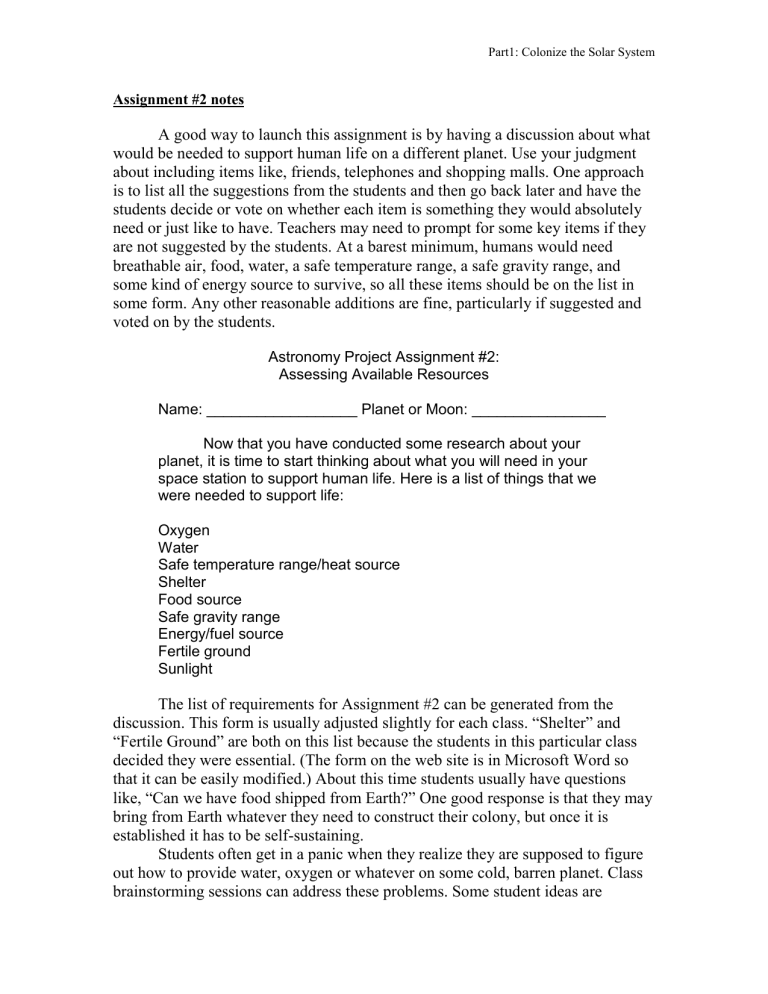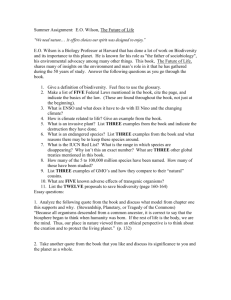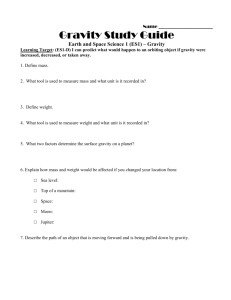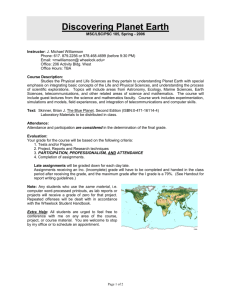Assignment 2 notes for teachers

Part1: Colonize the Solar System
Assignment #2 notes
A good way to launch this assignment is by having a discussion about what would be needed to support human life on a different planet. Use your judgment about including items like, friends, telephones and shopping malls. One approach is to list all the suggestions from the students and then go back later and have the students decide or vote on whether each item is something they would absolutely need or just like to have. Teachers may need to prompt for some key items if they are not suggested by the students. At a barest minimum, humans would need breathable air, food, water, a safe temperature range, a safe gravity range, and some kind of energy source to survive, so all these items should be on the list in some form. Any other reasonable additions are fine, particularly if suggested and voted on by the students.
Astronomy Project Assignment #2:
Assessing Available Resources
Name: __________________ Planet or Moon: ________________
Now that you have conducted some research about your planet, it is time to start thinking about what you will need in your space station to support human life. Here is a list of things that we were needed to support life:
Oxygen
Water
Safe temperature range/heat source
Shelter
Food source
Safe gravity range
Energy/fuel source
Fertile ground
Sunlight
The list of requirements for Assignment #2 can be generated from the discussion. This form is usually adjusted slightly for each class. “Shelter” and
“Fertile Ground” are both on this list because the students in this particular class decided they were essential. (The form on the web site is in Microsoft Word so that it can be easily modified.) About this time students usually have questions like, “Can we have food shipped from Earth?” One good response is that they may bring from Earth whatever they need to construct their colony, but once it is established it has to be self-sustaining.
Students often get in a panic when they realize they are supposed to figure out how to provide water, oxygen or whatever on some cold, barren planet. Class brainstorming sessions can address these problems. Some student ideas are
Part1: Colonize the Solar System amazingly ingenious, but teachers may also offer suggestions if the class is stumped. Some of these suggestions offer opportunities for demonstrations and activities in themselves, and they help to broaden the topic into other areas of science and technology, allowing you to cover other science standards in addition to astronomy. The opportunity to branch off into other scientific disciplines should be taken advantage of when possible. Teachers should feel free to go off on tangents to help students overcome obstacles to making the colony self-sustaining.
Your next step is to see which, if any, of these items are available on your planet. Your space station or colony will need to provide anysupplies that are not locally available. This is where you will have to be creative.
Need Provided by planet?
Other possible sources
Oxygen
Water
Safe temperature source
Food source
Safe gravity range
Energy/fuel source
Fertile ground
Light
How can you provide oxygen on a planet without an atmosphere? There are many possibilities. Oxygen is often trapped in other compounds, such as soil, or CO
2
. Build a machine to separate oxygen from other compounds. Another possibility is to
Part1: Colonize the Solar System grow a lot of plants and collect the oxygen that they give off. If hydrogen and oxygen are available, you can produce water by burning the hydrogen in oxygen. Fertile soil can often be developed by composting. Use your imagination. Remember, you may build your space station on your planet or on one of your planet’s moons
(if it has moons).
Use the chart on the back of this page to begin planning your space station. First decide which things that humans need in order to survive are already available on your planet or moon. Then put down other possible sources for the things that your planet does not provide.
This assignment is due on ________________.
Your final project is due on _____________. It will include a model of your space station and an essay about it. I will give you more specific information about the final requirements as we get closer to the due date. You will also have more preliminary assignments to help you prepare your project. Be sure to save all these assignments so that you can use them as you plan your project.
It should also be noted that it is not reasonable to expect these solutions to be 100% accurate. Some of the best minds in the world are working to solve some of these problems. The point is not to design something that will actually work in the real world; the point is to get students thinking about these issues and to propose solutions that are scientifically reasonable.
Here are some suggestions for generating solutions:
Safe gravity range - Gravity decreases as the distance from its source increases.
Build an orbiting space station to avoid being crushed by too much gravity. Using the inverse square rule, (gravity decreases by a factor of the square of the distance), it is possible to calculate approximately a safe distance from a planet with crushing gravity. If lack of gravity is an issue, an rotating space station will generate centripetal force to compensate for the lack of gravity.
Oxygen - Plants breathe in carbon dioxide and give off oxygen. Also, water can be broken down into hydrogen and oxygen using electrolysis.
Water - Burning hydrogen in pure oxygen produces water. Since the heat given off can be used to generate some electricity, interesting electrolysis/ hydrogen burning systems are possible. Water is also possible through distillation.
Food source - Growing plants give off oxygen.
Fertile ground - Compost the non-edible parts of plants.
Students also need to think about recycling and waste-treatment. There are waste-treatment systems that use marshes to purify water. Steam distillation of liquid wastes is also possible. Solid wastes can be screened off and composted to
Part1: Colonize the Solar System use as fertilizer. Methane is given off during the composting. This can be collected and used as a fuel source.
The possibilities for interconnecting these different systems are endless.
The purpose of Assignment #2 is to get students thinking about these possibilities.
Explain to the students that completing this assignment does not lock them in to a particular approach. They are free to change their plans, but they need to begin thinking about how they will provide the requirements for sustaining life that are not readily available on their planet.
All of these habitability problems are being addressed by the International
Space Station (ISS) currently being built. There is a lot of technical information about the ISS available over the internet. Students can research the life support systems of the ISS to get ideas for their own colonies: http://spaceflight.nasa.gov/station/ http://www.shuttlepresskit.com/ISS_OVR/ http://www.boeing.com/defense-space/space/spacestation/flash.html
Part1: Colonize the Solar System
Appendix
Standards Addressed
Benchmarks (Grades 3 through 5)
1A – The Scientific World View
Results of similar scientific investigations seldom turn out exactly the same. Sometimes this is because of unexpected differences in the things being investigated, sometimes because of unrealized differences in the methods used or in the circumstances in which the investigation is carried out, and sometimes just because of uncertainties in observations. It is not always easy to tell which.
3A – Technology and Science
Technology enables scientists and others to observe things that are too small or too far away to be seen without them and to study the motion of objects that are moving very rapidly or are hardly moving at all.
Technology extends the ability of people to change the world: to cut, shape, or put together materials; to move things from one place to another; and to reach farther with their hands, voices, senses, and minds. The changes may be for survival needs such as food, shelter, and defense, for communication and transportation, or to gain knowledge and express ideas.
3B – Design and Systems
There is no perfect design. Designs that are best in one respect (safety or ease of use, for example) may be inferior in other ways (cost or appearance). Usually some features must be sacrificed to get others. How such trade-offs are received depends upon which features are emphasized and which are down-played.
The solution to one problem may create other problems.
3C – Issues in Technology
Scientific laws, engineering principles, properties of materials, and construction techniques must be taken into account in designing engineering solutions to problems.
Other factors, such as cost, safety, appearance, environmental impact, and what will happen if the solution fails also must be considered.
Technologies often have drawbacks as well as benefits. A technology that helps some people or organisms may hurt others-either deliberately (as weapons can) or inadvertently (as pesticides can). When harm occurs or seems likely, choices have to be made or new solutions found.
4E – Energy Transformation
Things that give off light often also give off heat. Heat is produced by mechanical and electrical machines, and any time one thing rubs against something else.
5D – Interdependence of Life
Part1: Colonize the Solar System
For any particular environment, some kinds of plants and animals survive well, some survive less well, and some cannot survive at all.
Insects and various other organisms depend on dead plant and animal material for food.
5E – Flow of Matter and Energy
Almost all kinds of animals' food can be traced back to plants.
Some source of "energy" is needed for all organisms to stay alive and grow.
8B – Materials and Manufacturing
Naturally occurring materials such as wood, clay, cotton, and animal skins may be processed or combined with other materials to change their properties.
Through science and technology, a wide variety of materials that do not appear in nature at all have become available, ranging from steel to nylon to liquid crystals.
Discarded products contribute to the problem of waste disposal. Sometimes it is possible to use the materials in them to make new products, but materials differ widely in the ease with which they can be recycled.
8C – Energy Sources and Use
Moving air and water can be used to run machines.
11A – Systems
In something that consists of many parts, the parts usually influence one another.
Benchmarks (Grades 6 through 8)
3A – Technology and Science
Technology is essential to science for such purposes as access to outer space and other remote locations, sample collection and treatment, measurement, data collection and storage, computation, and communication of information.
3B – Design and Systems
Design usually requires taking constraints into account. Some constraints, such as gravity or the properties of the materials to be used, are unavoidable. Other constraints, including economic, political, social, ethical, and aesthetic ones, limit choices.
Almost all control systems have inputs, outputs, and feedback. The essence of control is comparing information about what is happening to what people want to happen and then making appropriate adjustments. This procedure requires sensing information, processing it, and making changes. In almost all modern machines, microprocessors serve as centers of performance control.
3C – Issues in Technology
Part1: Colonize the Solar System
Technology cannot always provide successful solutions for problems or fulfill every human need.
New technologies increase some risks and decrease others. Some of the same technologies that have improved the length and quality of life for many people have also brought new risks.
5E – Flow of Matter and Energy
Food provides molecules that serve as fuel and building material for all organisms.
Plants use the energy in light to make sugars out of carbon dioxide and water. This food can be used immediately for fuel or materials or it may be stored for later use.
Organisms that eat plants break down the plant structures to produce the materials and energy they need to survive. Then they are consumed by other organisms.
Over a long time, matter is transferred from one organism to another repeatedly and between organisms and their physical environment. As in all material systems, the total amount of matter remains constant, even though its form and location change.
8B – Materials and Manufacturing
The choice of materials for a job depends on their properties and on how they interact with other materials. Similarly, the usefulness of some manufactured parts of an object depends on how well they fit together with the other parts.
Manufacturing usually involves a series of steps, such as designing a product, obtaining and preparing raw materials, processing the materials mechanically or chemically, and assembling, testing, inspecting, and packaging. The sequence of these steps is also often important.
8C – Energy Sources and Use
Energy can change from one form to another, although in the process some energy is always converted to heat. Some systems transform energy with less loss of heat than others.
Different ways of obtaining, transforming, and distributing energy have different environmental consequences.
Electrical energy can be produced from a variety of energy sources and can be transformed into almost any other form of energy. Moreover, electricity is used to distribute energy quickly and conveniently to distant locations.
11A – Systems
Thinking about things as systems means looking for how every part relates to others. The output from one part of a system (which can include material, energy, or information)
Part1: Colonize the Solar System can become the input to other parts. Such feedback can serve to control what goes on in the system as a whole.
Benchmarks (Grades 9 through 12)
3A – Technology and Science
Mathematics, creativity, logic and originality are all needed to improve technology.
Technology usually affects society more directly than science because it solves practical problems and serves human needs (and may create new problems and needs). In contrast, science affects society mainly by stimulating and satisfying people's curiosity and occasionally by enlarging or challenging their views of what the world is like.
3B – Design and Systems
In designing a device or process, thought should be given to how it will be manufactured, operated, maintained, replaced, and disposed of and who will sell, operate, and take care of it. The costs associated with these functions may introduce yet more constraints on the design.
5E – Flow of Matter and Energy
The amount of life any environment can support is limited by the available energy, water, oxygen, and minerals, and by the ability of ecosystems to recycle the residue of dead organic materials. Human activities and technology can change the flow and reduce the fertility of the land.
8B – Materials and Manufacturing
Waste management includes considerations of quantity, safety, degradability, and cost. It requires social and technological innovations, because waste-disposal problems are political and economic as well as technical.
Scientific research identifies new materials and new uses of known materials.
8C – Energy Sources and Use
At present, all fuels have advantages and disadvantages so that society must consider the tradeoffs among them.
11A – Systems
The successful operation of a designed system usually involves feedback. The feedback of output from some parts of a system to input of other parts can be used to encourage what is going on in a system, discourage it, or reduce its discrepancy from some desired value.
The stability of a system can be greater when it includes appropriate feedback mechanisms.
National Standards (Grades 5-8)
Transfer of Energy
Part1: Colonize the Solar System
Energy is a property of many substances and is associated with heat, light, electricity, mechanical motion, sound, nuclei, and the nature of a chemical. Energy is transferred in many ways.
Electrical circuits provide a means of transferring electrical energy when heat, light, sound, and chemical changes are produced.
Understandings about Science and Technology
Science and technology are reciprocal. Science helps drive technology, as it addresses questions that demand more sophisticated instruments and provides principles for better instrumentation and technique. Technology is essential to science, because it provides instruments and techniques that enable observations of objects and phenomena that are otherwise unobservable due to factors such as quantity, distance, location, size, and speed. Technology also provides tools for investigations, inquiry, and analysis.
Perfectly designed solutions do not exist. All technological solutions have trade-offs, such as safety, cost, efficiency, and appearance. Engineers often build in back-up systems to provide safety. Risk is part of living in a highly technological world. Reducing risk often results in new technology.
Technological designs have constraints. Some constraints are unavoidable, for example, properties of materials, or effects of weather and friction; other constraints limit choices in the design, for example, environmental protection, human safety, and aesthetics.
National Standards (Grades 9-12)
Understandings about Scientific Inquiry
Scientists rely on technology to enhance the gathering and manipulation of data. New techniques and tools provide new evidence to guide inquiry and new methods to gather data, thereby contributing to the advance of science. The accuracy and precision of the data, and therefore the quality of the exploration, depends on the technology used.
The Interdependence of Organisms
Energy flows through ecosystems in one direction, from photosynthetic organisms to herbivores to carnivores and decomposers.
Matter, Energy and Organization in Living Systems
The energy for life primarily derives from the sun. Plants capture energy by absorbing light and using it to form strong (covalent) chemical bonds between the atoms of carbon containing (organic) molecules. These molecules can be used to assemble larger molecules with biological activity (including proteins, DNA, sugars, and fats). In addition, the energy stored in bonds between the atoms (chemical energy) can be used as sources of energy for life processes.
Energy in the Earth System
Earth systems have internal and external sources of energy, both of which create heat.
Part1: Colonize the Solar System
The sun is the major external source of energy. Two primary sources of internal energy are the decay of radioactive isotopes and the gravitational energy from the earth's original formation.
Indiana Standards
Grade 5
Science
–
Scientific Thinking
5.2.3 – Choose appropriate common materials for making simple mechanical constructions and repairing things.
Common Themes
5.6.1 – Recognize and describe that systems contain objects as well as processes that interact with each other.
Grade 6
Science – The Physical Setting
6.3.17 – Recognize and describe that energy is a property of many objects and is associated with heat, light, electricity, mechanical motion, and sound.
6.3.18 – Investigate and describe that when a new material, such as concrete, is made by combining two or more materials, it has properties that are different from the original materials.
Grade 7
Science – The Physical Setting
7.3.15 – Describe how electrical energy can be produced from a variety of energy sources and can be transformed into almost any other form of energy, such as light or heat.
7.3.16 – Recognize and explain that different ways of obtaining, transforming, and distributing energy have different environmental consequences.
Grade 8
Science – The Nature of Science and Technology
8.1.6 – Identify the constraints that must be taken into account as a new design is developed, such as gravity and the properties of the materials to be used.
Portions of this article were originally published by the Hoosier Science Teacher, 2004. Reprinted with permission









